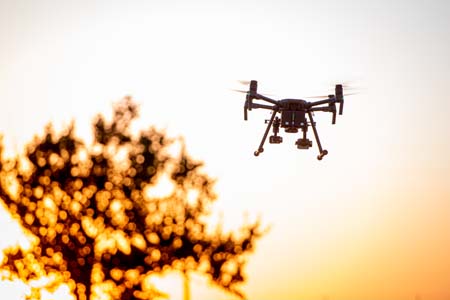Leader in the sky
Unmanned aircraft researcher pilots FAA projects
By Kimberly Bird
 Unmanned aircraft are becoming more common in our everyday lives: They can deliver our online orders, help farmers monitor crops, provide invaluable assistance in emergencies and disaster relief, or even help photographers capture beautiful images.
Unmanned aircraft are becoming more common in our everyday lives: They can deliver our online orders, help farmers monitor crops, provide invaluable assistance in emergencies and disaster relief, or even help photographers capture beautiful images.
But as more unmanned aircraft take to the skies, they also bring safety and security concerns to the U.S. airspace.
Tom Haritos is addressing those concerns. Through multiple research projects in the Applied Aviation Research Center on the Kansas State University Polytechnic Campus, Haritos is leading a team of innovators who are developing ways to safely integrate unmanned aircraft systems, or UAS, into U.S. airspace.
The research comes at an exciting time for the UAS industry.
“The aviation paradigm associated with unmanned aircraft systems is experiencing revolutionary growth,” said Haritos, UAS research program manager at K-State Polytechnic. “Industry expansion efforts have provided many opportunities for the Applied Aviation Research Center and K-State Polytechnic to continue at the forefront of this evolving industry.”
Haritos oversees collaborative research with the Federal Aviation Administration through the Alliance for System Safety of UAS through Research Excellence, also called ASSURE. K-State Polytechnic is a member of ASSURE, which is the FAA’s Center of Excellence for Unmanned Aircraft Systems. ASSURE involves 24 world research institutions and more than 100 industry and government partners.
Under Haritos’ direction, K-State is currently the lead university for three research projects that total more than $1 million in FAA funding.
The research projects cover areas such as UAS operations over people and UAS operations beyond visual line of sight, which is when an aircraft is no longer visible by the remote pilot. Research from K-State and partnering institutions also is providing direction on safety assessments when the FAA receives waiver requests for UAS operations.
Haritos is helping the FAA develop safety standards for UAS operating in the National Airspace System — where UAS pilots, manned pilots, air traffic controllers and more all interact with each other.
K-State is a nationally recognized leader in UAS research, operations and training. Haritos’ leadership in these research areas is providing new transportation solutions and economic benefits.
“Unmanned aircraft systems are a reality and the integration of these systems into the National Airspace System is certainly coming to fruition,” Haritos said. “I believe the technology alone is fascinating and incorporates many scientific domains outside of aviation, such as aspects of computing technology, human-machine interface design and communication protocols.”